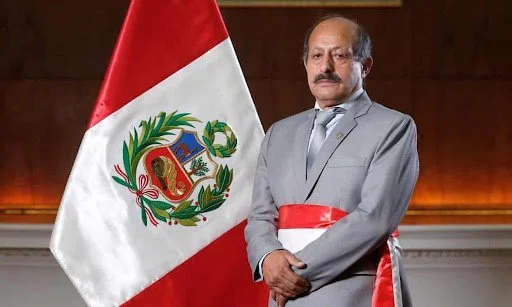Peruvian President Names Fourth Prime Minister
Peru's President Pedro Castillo (left) swears in Anibal Torres as his new prime minister. Photo: Martin Mejia/AP
Earlier this month, Peruvian President Pedro Castillo appointed Anibal Torres as his fourth prime minister in half a year. The prime minister is the chief advisor to the president and helps appoint the cabinet—when one resigns, the cabinet is dissolved and each minister must be reappointed. President Castillo has announced his fourth cabinet, and now has 30 days for Congress to give a vote of confidence.
Prime Minister Torres had been the head of the judiciary ministry since Castillo took office in July of last year. He is known for his antagonistic position towards former President Alberto Fujimori, as well as his daughter and current oppositional politician, Keiko Fujimori. Formerly an independent lawyer who called for constitutional reform, Torres is replacing Hector Valer Pinto, who assumed the position for four days.
The string of Castillo’s prime ministers begins with Guido Bellido, a far-left party leader who resigned in October due to political instability and controversy. He was succeeded by Mirtha Vasquez, who stepped down at the end of January over internal disagreements. The third, Valer, was dogged by allegations of domestic violence against his wife and daughter, and criticism from both the opposition and his own party. As pressure built and women’s organizations began to mobilize, he chose to resign.
Because each prime minister change includes a cabinet reshuffle, President Castillo has made several changes. Doctor Hernan Condori is the new health minister responsible for tackling the Omicron variant of COVID-19. Nuclear physicist Modesto Montoya has become the environment minister, and faces the January oil spill crisis. Meanwhile, Finance Minister Oscar Graham and Foreign Minister Cesar Landa have remained.
Héctor Valer poses for a photograph after being named prime minister by Peru's president, Pedro Castillo, in Lima on Feb. 1. Photo: Reuters
President Castillo has been in office for over six months. As a “campesino” and rural school teacher, his campaign against Keiko Fujimori ran on promises for social welfare and income equality. He was a breath of fresh air after several corruption scandals, due to his disconnect from the corrupt Lima establishment.
Castillo has been facing serious political instability and polarization. Peru has seen four presidents in five years, as well as the November 2020 constitutional crisis with President Martín Vizcarra. The unicameral congress is very powerful and is currently controlled by the conservative opposition. Moreover, the socialist Free Peru party—that Castillo ran under but is trying to distance himself from—is rife with tension and infighting.
Due to Castillo’s social positioning away from the left and towards the center, as well as several controversial cabinet decisions, he has accumulated enemies within his own party. Even worse, the opposition attempted to impeach him in December. He is trying to balance an uncooperative, oppositional Congress in addition to disgruntled members of the Free Peru party.
Prime Minister Torres reflects this dilemma: he fired an attorney general politically positioned against President Castillo. His actions sent “a clear message that the president is not willing to improve the quality of his team,” explains Alexandra Ames, a Pacific University political analyst.
Beyond political issues, Peru is struggling with the pandemic, endemic corruption, and a surge in crime in Lima that has led to a state of emergency. Despite high economic growth, the country’s political uncertainty and constant changes in leadership will continue to be a serious concern for Castillo.


